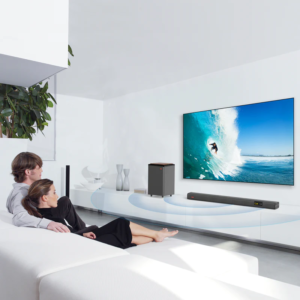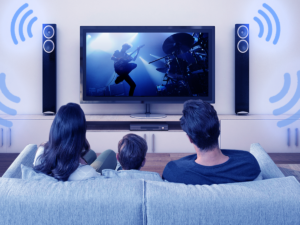The most important thing for an immersive cinema experience at home is an efficient surround sound setup. However, the setup involves a lot of wires, settings, and arrangements, which together can make things messy.
One such mess occurs when all your surround sound speakers fail to perform up to the mark. There are many reasons because of why such problems arise and it depends mainly on which speakers aren’t working.
Luckily, these problems have simple fixes.
So, if you are experiencing issues with your surround sound speakers check out these best ways to rectify the problem and get things working again!
Surround Sound – What is it?
The surround sound system uses numerous audio channels and a range of speakers to reproduce audio. It leads to a more natural sound emulation than the standard 2-channel stereo setup.
The more audio channels are added to a given configuration, the higher the potential for spatial reproduction of sound. The commonly used configurations of sound are 5.1, 9.1, and 7.1.
The second number mentions the low-frequency channels that exist. It is rectified using a low-pass filter and extends frequencies higher than 120Hz. To take full advantage of this advanced technology, you must facilitate more precise audio reproduction by adding more height information.
≠ Fix 1 – When None of the Speakers is Working
Your speakers are placed in the correct positions, wires are installed correctly, and all settings are been made. You are all set to enjoy an incredible experience, but suddenly you find that there is no sound coming from any of the speakers.
Here’s the quickest way to resolve this issue:
- Power off your speakers and unplug the speakers.
- Recheck all the connections properly – speaker wires, power cables, tightly held bare wires, and others.
- Test the receiver’s settings and speaker settings. Go through all the setting options.
- If still, the problem persists, you need to assign speakers and channels.
≠ Fix 2 – Surround Speakers are Delivering No Sound
Before delving into the technical details, you must check the speaker’s volume. It must be turned up. If your surround speakers are releasing no sound, you need to follow these steps.
- The speaker connections must be correctly set.
- If you are experiencing this issue while playing music from the receiver, this is a standard problem. It is because most songs are mixed for not playing than two channels.
- The receiver setting must turn to 5.1 audio or a higher level.
- Check the DSP settings.
- Test the sources for their efficiency and capability.
- The output must be set to a multiple-channel stream.
≠ Fix 3 – Front Speakers are Delivering Poor Sound
It is possible that while setting up the surround system you haven’t placed the front speakers correctly or they are facing too much bass load. This could result in distorted sound that occurs while playing the music. Hence, it is best to adjust the sound system to 80Hz or above.
There is another fix to this issue. You need to check the receiver settings. If the front speaker is producing a weird sound, then this may be because of the incorrect settings in the speaker size. You must pick medium to large-sized speakers.
≠ Fix 4 – Height Speakers Produce Poor Sound
Ceiling and height speakers are challenging to install but fixing them is very simple.
- Work on the codec settings of the receiver.
- Might be your height speakers are facing interruptions because of the wrongly bouncing waves.
- Place speakers in new positions and see if there is any difference.
- Check the manual to see if there is any special place recommended by the manufacturer.
≠ Fix 5 – No Bass
If no bass comes from the speakers, you need to change the crossover frequencies. You need to start at 80Hz and adjust by small levels.
≠ Fix 6 – Distorted Sound Coming from the Speakers
Buzzing or humming noises is again a common problem in the surround sound system. Here are the main reasons, which can cause it.
Problem in the System – First, disconnect everything from the receiver to check if the noise stops coming. Then connect to the system one by one to find out the real troublemaker.
Problem with the Cable – There can be issues with the TV cable. In this case, you must disconnect the TV cable from the other attachments to the system. If the noise stops, it means there is a problem with your TV cable.
Problem in the Outlet – If the above-mentioned tips do not work, there must be an issue in the outlet. This issue can be prevented by placing the device on another outlet, which is electrically isolated. This is done by using isolation transformers. But this is a tricky task, and hence, we suggest you must hire a professional. It is because considering the safety regulations is very important.
Check All the Connections
The RCA cable connecting the receiver and subwoofer must be connected correctly.
The subwoofer must be located upfront. It must be away from the walls, a corner, any side of the watching position, or close to front speakers.
Place the subwoofer in the listening area and on the floor to identify the best sound from the bass. Then, you can put it in the correct position.
Final Thoughts
Making all your surround speakers work is a trial-and-hit method. It is quite challenging to find out the exact cause of the issue. It is simple to fix some problems while difficult to manage others. Some issues may need professional assistance. You can try most of these fixes on your own, but if you are unable to deal with electricity and wires, it is best to hire an expert.
- Will Volume On TV Work For Speakers Connected To TV?

- How To Turn Off Your Bose 700 Headphones | Quick Method

- How To Connect External Speakers To LG TV? [3-Step Process]

- Can You Use Coax As A Speaker Cable? [5 Methods]

- WHAT ARE THE WAYS TO CONNECT 4 SPEAKERS TO A 2 CHANNEL AMP DIAGRAM?

- Turtle Beach – Recon 50X White Stereo Gaming Headset Vs Xbox Stereo Headset
